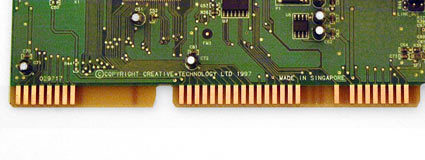Graphics Beginners' Guide, Part 1: Graphics Cards
Graphics Card Interfaces
This is the location of the graphics card interface, which nowadays can be AGP or PCI Express.
This is the part of the video card that plugs into your computer's motherboard. It is through this slot, or 'interface', that your graphics card and computer hand each other information. Since most motherboards only have a single type of graphics card slot, it is very important to buy a graphics card that matches the slot on your motherboard. For example, a PCI Express graphics card will not work in an AGP card slot. Not only will it not fit physically but the protocols for data transmission are different.
The most important aspect of a graphics card interface is the bandwidth. The term "bandwidth" refers to the amount of information that can pass through the interface in a given time.. The more bandwidth the interface offers, the faster a graphics card can perform - in theory. In practice, however, the interface is far less important than what the industry claims.
ISA
ISA stands for Industry Standard Architecture
Displayed here only for reference, this is the oldest PC card standard interface. Graphics cards with this interface became obsolete a long time ago. In fact, you won't even be able to buy a motherboard today with an ISA slot.
There are 8 bit and 16 bit ISA cards; only the latter uses both connector blocks (see image). EISA or Extended ISA cards were introduced for motherboards with higher bandwidths at 32 bits wide, and they offered bus mastering. However, they were expensive and were phased out when newer interfaces were commercialized.
Get Tom's Hardware's best news and in-depth reviews, straight to your inbox.
PCI
The 32 bit classic PCI bus. Still today it is used for all sorts of expansion cards.
PCI stands for Peripheral Components Interconnect. It is a 32 bit wide bus that runs at 33 MHz, delivering a bandwidth of 133 MB/s. The PCI interface replaced ISA and its extensions (VL - Vesa Local Bus) in the 1990s, with the benefit of much higher bandwidth. PCI is the current standard for most computer add-in cards, but contemporary graphics cards no longer use PCI, as they have long since moved on to the AGP (and PCI Express) interface.
In many cases, however, computers from large manufacturers will come without an AGP or PCI Express port for future graphics expansion. In order to upgrade the graphics card on these machines, the only option is a video card with a PCI interface, but these are scarce, overpriced and have low performance.
PCI-X
PCI-X stands for 'Peripheral Component Interconnect - Extended', which can be taken literally: Its 64 bit wide interface delivers up to 4,266 MB/s, depending on the bus clock speed. PCI-X (not to be confused with PCI Express!) was first a speed upgrade to the PCI bus, but was upgraded with certain features that are required in the server space. It is not very common in ordinary PCs, and PCI-X graphics cards are very rare. You can use a PCI-X card in a regular PCI slot as long as it is a current revision (PCI 2.2 or higher), but you cannot add them to your motherboard with a PCI Express slot.
Don Woligroski was a former senior hardware editor for Tom's Hardware. He has covered a wide range of PC hardware topics, including CPUs, GPUs, system building, and emerging technologies.
-
srinivasgtl Is it possible to get different output on different output ports on the graphics card? I want to play two different streams and use the two ports of the same graphics cards to display these streams on two different TV's. Is this possible?Reply


